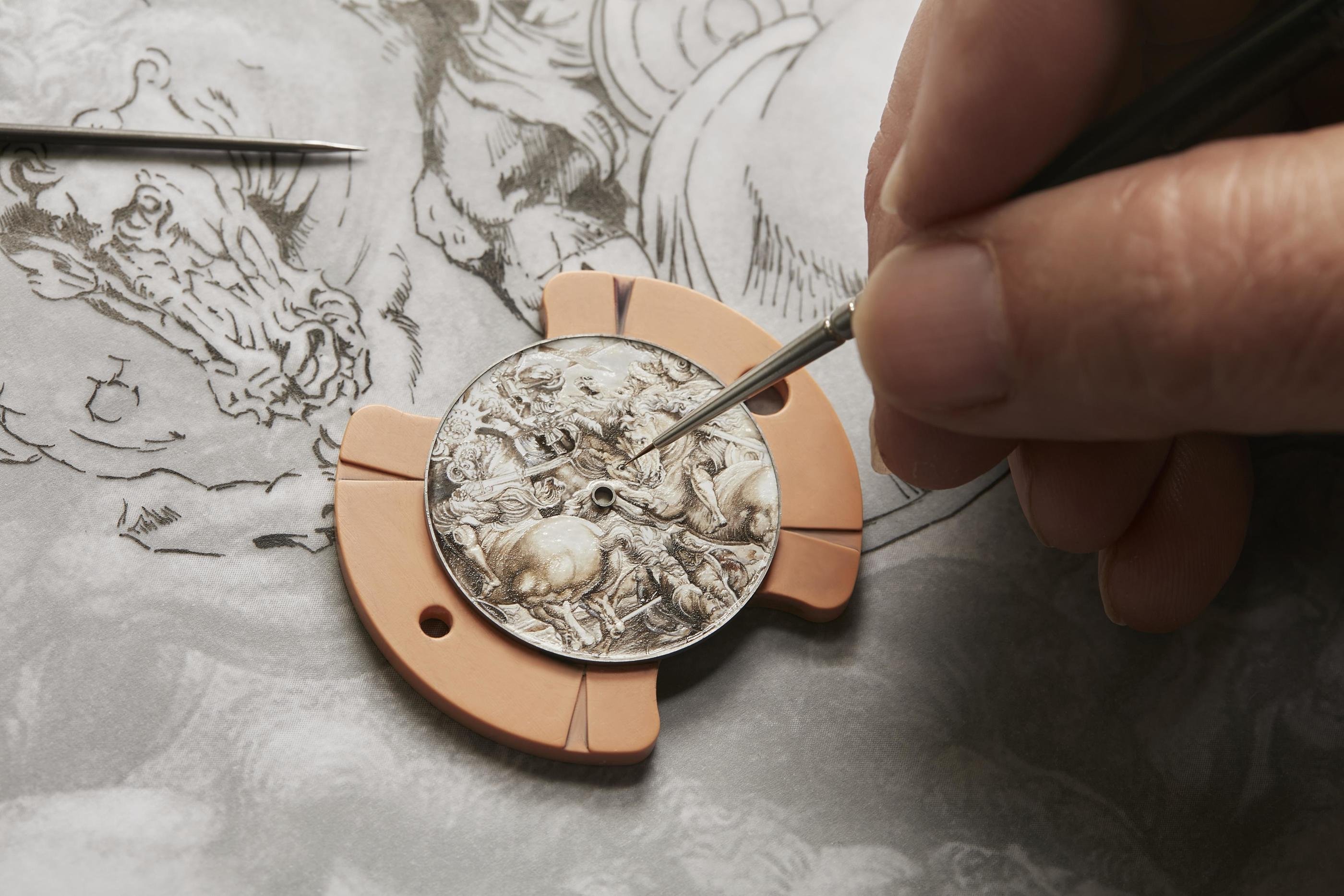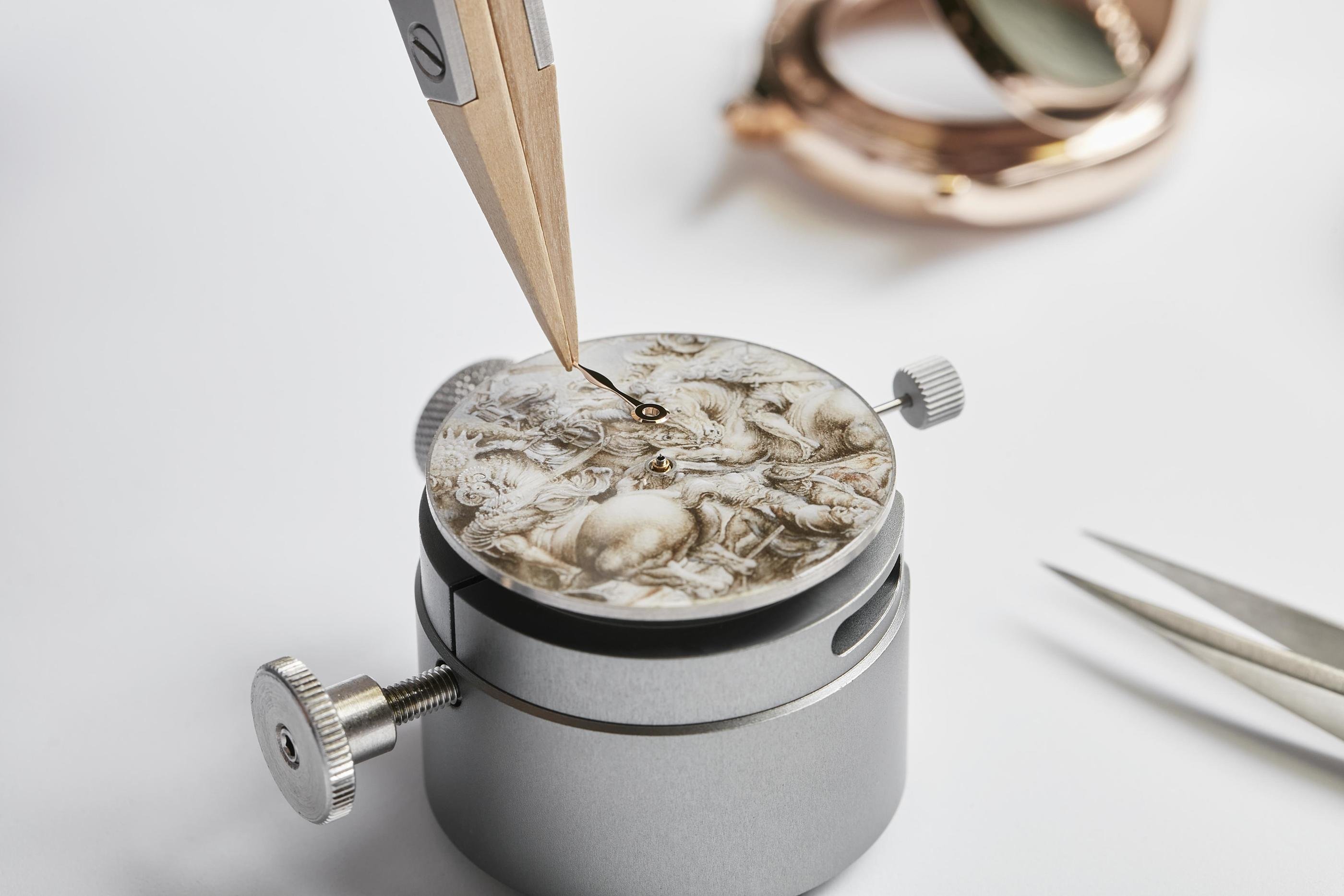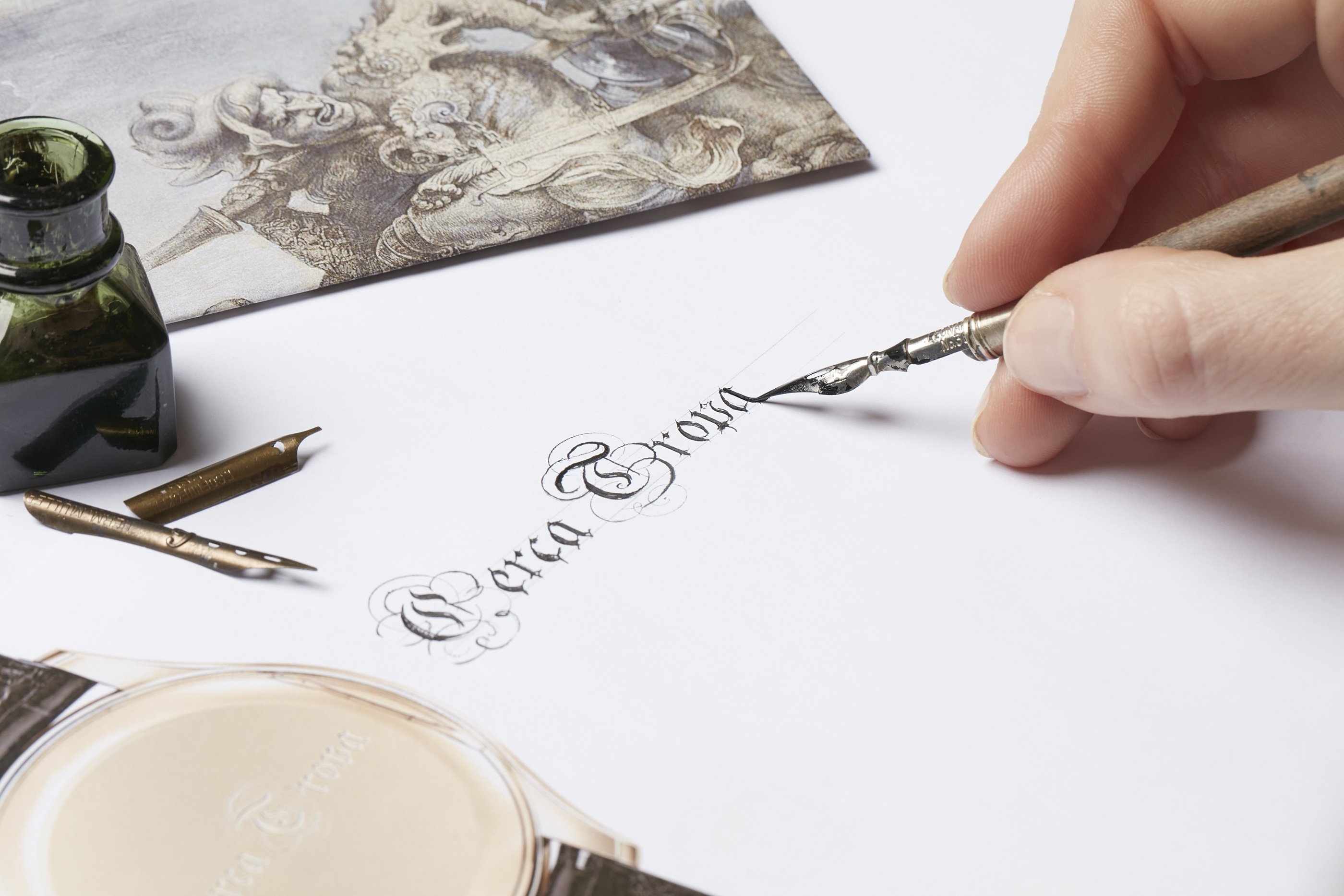ince its founding in 1755, Vacheron Constantin has devoted great importance to arts and culture. The partnership with the Louvre Museum that began in 2019 betokens a celebration of beauty driven by the Manufacture’s constant concern for safeguarding and passing on of heritage.
A bespoke Les Cabinotiers watch was auctioned off at the “Bid for the Louvre” sale organised to benefit the museum’s solidarity projects in December 2020, initiating a new offer entitled “A masterpiece on the wrist”. After two years featuring a wealth of discoveries including the winning bidder’s private visit to the museum and the Manufacture in order to discuss the project with the Louvre’s experts and the Maison’s Master Artisans, the adventure gave birth to a single-piece edition watch: Les Cabinotiers – Homage to Pierre Paul Rubens, La lutte pour l’étendard de la Bataille d’Anghiari. Its miniature enamel dial faithfully reproduces the eponymous drawing by Peter Paul Rubens.
In 2021, the collaboration between the Manufacture and the prestigious museum also featured a chance to explore of the art studops of the two institutions through a series of videos illustrating a parallel between the work of their respective master artisans. This was followed in 2022 by the launch of a series of four watches inspired by the museum’s antique collections: Métiers d’Art – Tribute to Great Civilisations. In 2023, the partnership between Vacheron Constantin and the Louvre will be further expanded with a new Les Cabinotiers offer titled “A Masterpiece on the Wrist” and which will enable clients to choose from among the museum’s works of art the one that will be reproduced in enamel on the dial of their watch.
After its support for the 2016 restoration of the clock named The Creation of the World – a major work of 18th century precision horology presented to King Louis XV in 1754 and deposited with the Louvre by the Musée National des Châteaux de Versailles et de Trianon – Vacheron Constantin entered into a partnership with the Louvre in 2019. This collaboration echoes the respective legacies of the two institutions, which share the same respect for history, culture and heritage.
This year, the Manufacture is pleased to announce the continuation of this important partnership. “I enthusiastically welcome this collaboration between our two institutions, both centuries-old yet firmly rooted in the 21st century, as evidenced by the favour they enjoy among an audience of connoisseurs”, said Louis Ferla, CEO Vacheron Constantin. "Our Maison has long since stood out in terms of both artistic commitment and cultural patronage. With the Louvre Museum, we are writing an extremely promising joint history by combining our fields of competence and our wildest dreams.”
Since its founding in 1793, the Louvre has been both a showcase for the finest masterpieces of our common heritage and home to contemporary creative talents. It shares with Vacheron Constantin a concern for long- term perspectives, excellence and dialogue between past and present-day artists.
“I am delighted with this collaboration, which is full of fruitful exchanges between our teams and marked by a shared desire to serve Beauty”, points out Laurence des Cars, President and Director of the Louvre. " Born in the Age of Enlightenment, our two institutions share the mission of passing on a passion for art, heritage and the excellence of ancestral craftsmanship. While firmly rooted in history, they are resolutely open to the contemporary world.”
This partnership with the Louvre confirms Vacheron Constantin’s cultural commitment, covering areas specific to centuries-old, world-renowned institutions, for which the archiving, conservation and restoration of heritage are determining factors. This attachment to the splendours of the past and to the transmission of know-how is synonymous with great respect for the craftsmanship that is essential to Vacheron Constantin’s creations as well as to the Louvre’s activities.
-

- La lutte pour l’étendard de la Bataille d’Anghiari, by Pierre Paul Rubens
In December 2020, Vacheron Constantin took part in an auction to support a vast project of educational workshops at the Louvre, with 100% of the proceeds going to support Le Studio, a place of discovery and sharing open to all in order to help people familiarise themselves with the museum, its collections and its crafts, including an introduction to the techniques of the plastic arts.
In this spirit, Vacheron Constantin offered a unique experience, embodied by a single-piece edition bespoke Les Cabinotiers watch whose dial was to be personalised with a miniature or grisaille enamel reproduction of an artwork kept in the Louvre and chosen by the buyer. Guided by the museum’s experts, the successful bidder also had the privilege of a private tour of the museum and the Cabinet des Dessins, a place accessible to the public by reservation only, in order to determine the work to be reproduced. This is where the original drawing finally chosen – La lutte pour l’étendard de la Bataille d’Anghiari, by Pierre Paul Rubens – is kept.
The drawing by Pierre Paul Rubens has an extraordinary historical background. During his stay in Italy during the early 17th century, the Flemish painter is said to have purchased and then retouched in ink, wash and gouache this sheet depicting the Battle of Anghiari, a vast composition that Leonardo da Vinci was commissioned to create for the Great Council Chamber of the Palazzo della Signoria – which subsequently became Palazzo Vecchio – in Florence.
Regarded as one of the artist’s great masterpieces, the huge painting – celebrating a famous victory of the armies of Pope Eugene IV and the republics of Venice and Florence over those of the Duke of Milan – was left unfinished by Leonardo in 1506 and deteriorated very quickly. Virtually nothing remained when in the mid- 16th century, at the request of Duke Cosimo I, Giorgio Vasari restructured the room to become the present Salone de’ Cinquecento and covered the walls with a new decor exalting the deeds of the Medici house. Could the remains of the Battle of Anghiari have been preserved under Vasari’s frescoes? To date, no one has provided proof of this, and attempts to find them, particularly beneath the Battle of Marciano, have proved completely unsuccessful.

Analysis of the Louvre sheet using the infrared reflectography technique, which accentuates traces containing carbon, has confirmed the presence under Rubens’ later interventions of a drawing attributable to an anonymous artist copying the cartoon – Leonardo’s large preparatory drawing for the mural – of the Battle of Anghiari.
The proven mastery of his art and the creative freedom prevailing in Vacheron Constantin’s Métiers d’Art workshop enabled him to approach the challenge in a new and innovative way. It was clear from the outset that the Geneva miniature painting technique would be the most appropriate way to pay tribute to the original work. The Maison’s master enameller nevertheless broadened the scope of the traditional technique by deciding to incorporate blanc de Limoges, generally used in grisaille enamel. This is one of his specialities to which he adopts an empirical approach and after 30 years of exercising this craft he is still experimenting with its multiple possibilities.
Working with multiple instruments and drawing on the many secrets of enamel alchemy, he has used brushes with three to four bristles, pointed tools as well as cactus spines. The ancestral technique of miniature enamelling with a Geneva flux undercoat consists of adding a final transparent and colourless protection to the layers of vitrified enamel, bringing brilliance and depth to the artisan’s work. The grisaille enamel has been interpreted in an original way on this timepiece, since the master enameller wished to create depth-effect highlights with the help of blanc de Limoges, in order to give greater relief and movement to the horse’s mane.
After using line drawing to clearly mark out the details of the contours, the outline of the dial was drawn. Successive stages sought to recreate the extreme subtlety of Rubens’ drawing, all in very light and diffuse shades and half-tones. The master enameller used about 20 shades of brown, grey brown, sepia brown and cream brown, an impressive number alternating with as many firings at 900°C, the first layers being fired very lightly, just long enough to start vitrifying, so as to follow the firing without altering the first shades.
In a dialogue between artists across the centuries, he has drawn on his expertise in grisaille enamel, born of years of practice in Limoges, to reproduce the sensitivity of the artwork with a multitude of interlocking micro-details identically replicated while retaining the graphics and specificities of the original work. As unprecedented as it is brilliantly executed, this combination of miniature enamel and grisaille enamel has given rise to a timepiece driven by in-house Calibre 2460 SC, featuring an oscillating weight engraved with a depicting of the Louvre’s east-facing facade.
Passed down from generation to generation within the Maison for more than 267 years, the masterful art of engraving has extended the artistic dimension of the 18K 5N pink gold watch, through its officer-type caseback engraved with 17th century “Cerca Trova” calligraphy.
The motto Cerca Trova (He who seeks finds), which is now visible on one of Vasari’s frescoes, is not related to Leonardo’s lost Battle of Anghiari, but was instead of way for Cosimo de’ Medici to thumb his nose at Florentine, Sienese and French enemies, with whom he had numerous quarrels.

This new “A masterpiece on your wrist” offer involves the creation of a bespoke single-piece edition watch with a dial featuring an enamel reproduction of an artwork kept in in the Louvre Museum and chosen by the purchaser. A certificate of authenticity from the museum will certify the reproduction. The experience will be accompanied by a private tour of the Louvre in the company of its experts and the Manufacture Vacheron Constantin to meet its master watchmakers and master artisans.
In a thoroughly modern way, Vacheron Constantin is thereby perpetuating the grand tradition of the Cabinotiers in the Age of Enlightenment and which the Maison began to practise on 17 September 1755 when Jean-Marc Vacheron signed his first apprenticeship contract with a young watchmaker in Geneva. At that time, the city’s artisans worked in cabinets installed in attics, on an overhanging floor called a “dome” because it was bathed in daylight. They were known as cabinotiers. The name has stuck, as has the duty to adopt a resolutely demanding approach to their craft.
TECHNICAL SPECIFCATIONS
Les Cabinotiers – Homage to Pierre Paul Rubens, La lutte pour l’étendard de la Bataille d’Anghiari
Reference
- 2400C/000R-114C
Calibre
- 2460 SC
- Developed and manufactured by Vacheron Constantin
- Mechanical, self-winding
- 26.2 mm (111⁄4’’’) diameter, 3.6 mm thick
- 22K pink gold oscillating weight with the Louvre eastern façade engraving Approximately 40 hours of power reserve
- 4 Hz (28,800 vibrations per hour)
- 182 components
- 27 jewels
- Hallmark of Geneva certified timepieces
Indications
- Hours, minutes and center seconds
Case
- 18K 5N pink gold
- Officer-type caseback, with line engraving
- 40 mm diameter, 9.42 mm thick
Dial
- Miniature and grisaille enamels
- 18K 5N pink gold hands
Strap
- Brown Mississippiensis alligator leather
Buckle
- 18K 5N pink gold pin buckle
Box
- Les Cabinotiers box
Single-piece edition
Certificate of Authenticity for the reproduction of the masterpiece issued by Le Louvre
Certificate of Guarantee issued by Vacheron Constantin












